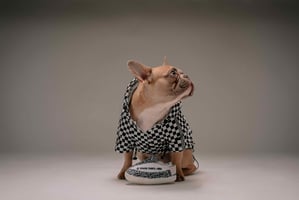Potty training your puppy can be a daunting task, but it doesn't have to be. With the right...
How to Toilet Train Your Puppy in 7 Easy Steps
Toilet training your puppy doesn't have to be a hassle. With the right approach, you can successfully toilet train your puppy in as little as a week. In this article, we'll discuss how to toilet train a puppy, the most common mistakes to avoid, and how to establish a successful potty training routine.
Step 1: Prepare the Potty Area
The first step in toilet training your puppy is to create an area for them to use as their bathroom. This could be either a designated spot outside in the yard, or an indoor area with a litter box or pee pads. Whichever option you choose, make sure that you provide your puppy with plenty of praise when they use it correctly.
Tip: If you’re using an indoor potty area, make sure to clean it regularly and replace the pee pads or litter box when needed.
Step 2: Set a Schedule
The next step in toilet training your puppy is to set a potty schedule. This should include regular bathroom breaks, as well as scheduled times for eating and playing. When your puppy goes to the bathroom in the correct area, make sure to give them plenty of praise and reward them with treats.
Tip: Make sure to stick to the schedule as much as possible, as consistency is key to a successful potty training routine.
Step 3: Use a Crate
Using a crate can be a great way to help your puppy learn where to go to the bathroom. The crate should be the right size for your puppy and placed in a quiet area of your home. When you’re not able to supervise your puppy, put them in the crate to help prevent any accidents.
Tip: Make sure to give your puppy plenty of time outside of the crate to explore and play.
Step 4: Establish a Cue
Establishing a cue can help your puppy learn to recognize when it’s time to go to the bathroom. This could be a simple word or phrase, such as “go potty” or “go outside.” When they go to the bathroom in the correct area, make sure to give them lots of praise and reward them with treats.
Tip: Make sure to use the same cue each time, as this will help your puppy learn faster.
Step 5: Increase Supervision
When it comes to toilet training your puppy, supervision is key. Make sure to keep an eye on your puppy while they’re exploring and playing, as this will help you catch any accidents before they happen. If you notice your puppy starting to sniff or circle, take them outside immediately.
Tip: If you’re not able to supervise your puppy, put them in their crate or a gated area.
Step 6: Clean Up Accidents
Accidents are inevitable when it comes to toilet training your puppy, so it’s important to clean them up quickly and thoroughly. Use an enzymatic cleaner to remove any lingering odors, as this will help prevent your puppy from returning to the same spot to go to the bathroom.
Tip: Make sure to avoid using any harsh chemicals, as these can be toxic to your puppy.
Step 7: Be Patient
Finally, remember that toilet training your puppy takes time and patience. Don’t get frustrated if your puppy has accidents or doesn’t seem to be making progress. With time and consistency, you’ll be able to successfully toilet train your puppy.
Tip: If you’re having trouble with your puppy’s potty training, consider enlisting the help of a professional dog trainer.
Common Mistakes to Avoid
When it comes to toilet training your puppy, there are a few common mistakes that you should avoid:
- Not using a crate: Using a crate can be a great way to help your puppy learn where to go to the bathroom. Make sure to give your puppy plenty of time outside of the crate to explore and play.
- Not establishing a potty schedule: Setting a potty schedule and sticking to it is key to a successful potty training routine. Make sure to provide your puppy with regular bathroom breaks and scheduled times for eating and playing.
- Not cleaning up accidents: Accidents are inevitable when it comes to toilet training your puppy, so it’s important to clean them up quickly and thoroughly. Use an enzymatic cleaner to remove any lingering odors.
- Getting frustrated: Toilet training your puppy takes time and patience. Don’t get frustrated if your puppy has accidents or doesn’t seem to be making progress. With time and consistency, you’ll be able to successfully toilet train your puppy.
Conclusion
Toilet training your puppy doesn't have to be a hassle. With the right approach, you can successfully toilet train your puppy in as little as a week. Remember to prepare a potty area, set a schedule, use a crate, establish a cue, increase supervision, clean up accidents, and be patient. Avoiding common mistakes such as not using a crate, not establishing a potty schedule, not cleaning up accidents, and getting frustrated will help you ensure a successful potty training routine. With time and consistency, you’ll be able to successfully toilet train your puppy.



